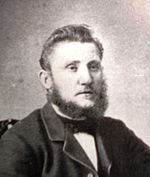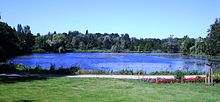Development of the spa and bathing system in Bad Schwartau
The development of the spa and bathing system in Bad Schwartau includes the various historical spa facilities and their development over time. The spa and bathing system had a central influence on the development of Bad Schwartau (which became known as the “iodine brine and mud spa of the north”) from 1901 and still has a major influence on its shape today.
Before 1900
Towards the end of the 19th century, Schwartau developed into a summer resort popular with many visitors .
In 1895 a brewery drilled a hole in order to obtain pure deep water for the production of seltzer water . At a depth of 316 meters, the borehole encountered a layer of soil containing a salt solution ( brine ). An analysis of the brine showed an approx. 3.5 percent salt content - with an iodine content of approx. 4 per thousand, which is high for northern Germany . Plans on the part of the brewery owner to use the brine spring for bathing purposes came to nothing, as a high purchase price was demanded for the required land.
After 1900

The former master brewer of the Anton Baumann brewery (the brewery had ceased operations in 1900) began building a bathhouse in the spring of 1901, which on June 7th 1901 was known as the "Elisabeth-Sol- und Moorbad" (named after the wife of the Grand Duke of Oldenburg ) was opened - this time is the actual beginning of the development of the spa and bathing system in Bad Schwartau. This immediately enjoyed great popularity (around 5,000 baths were administered in 1901) and made Schwartau a well-known spa and bathing resort within a short time.
In order to build on the success of the Elisabeth-Sol- and Moorbad, the Schwartau citizen Johann Niemann - operator of a "cold bathing establishment" - carried out a successful drilling for brine up to 305 meters and opened the "Friedrich-August-Bad" (named after Friedrich August , Grand Duke of Oldenburg ).
After the site of the former brewery was sold to the Fromm brothers' chemical factory (the forerunner of the Schwartau works ) in 1905 , the "Elisabeth-Sol- und Moorbad" lost access to the brine spring (the "Elisabeth spring") the new owners intended to use them themselves. Then in 1905/1906 another borehole (the "Anton-Baumann-Quelle") was drilled down to 327 meters on the site of the "Elisabeth-Sol- und Moorbad" and from then on the brine for the operation of the bath was taken from this spring .
The Schwartau Kurhaus (with an associated spa park) was built by a union of some Schwartau citizens and opened on June 18, 1908.
Triggered by the three bathrooms sharp rise of tourism led to the opening of many hotels for spa guests and a rapid development of the town Schwartau what 1912 awarding the town charter , and on May 31, 1913 for recognition as " Bad " through the baths Association led.
Advertisement of the Elisabeth-Sol- und -Moorbath (the widow of Anton Baumann ) (1910)
After 1914
With the beginning of the First World War there was a sharp decline in tourism, which resulted in the closure of the "Friedrich-August-Bad". After the end of the First World War, the “Elisabeth-Sol- und Moorbad” went to the Schwartauer Werke, which ran it as a subsidiary. From 1920 the Kurhaus became the property of the city of Bad Schwartau - also for economic reasons.
An expansion of the Schwartau works made it necessary to demolish the Schwartau Kurhaus and remove the associated spa gardens in 1936/37.
A new spa park was created further north around the Schwartauer See, which was excavated by the Reich Labor Service in 1934/35 .
After 1945

The "Elisabeth-Bad", which continued as a subsidiary of the Schwartauer Werke, was bought on January 2, 1957 by the city of Bad Schwartau. From 1959 the "Elisabeth-Bad" and its facilities of the Kurmittelhaus were extensively expanded and modernized. A spa guesthouse was built next to it. These measures led to a sharp increase in the number of spa guests.
In 1969 the city spa facilities are transferred to a Kurbetriebs-GmbH in order to build new spa homes, a sanatorium "Haus am Kurpark" and other spa facilities in this legal form in the following years . This leads to a further increase in the spa business in Bad Schwartau.
In 1978, a new spa center was opened near the spa park on Schwartauer See, where a new brine source was drilled at a depth of 275 meters.
When the spa center was completely relocated to a new building in the spa gardens in 1983, the spa operations were completely relocated from their original location and the Elisabeth baths ceased operations. For the transport of the moor for mud baths, an approx. 1580 meter long " moor pipeline" was laid between the newly constructed processing and extraction site in Danneberger Moor and the spa center in 1984 in order to avoid the number of truck transports required for this purpose. In order to make the iodine brine accessible to non-spa guests, an iodine brine thermal bath was built, which was opened in 1989 as the “Holstein Therme”.
On March 1, 1994, the town of Bad Schwartau sold the town's private health spa to secure the continued existence and future development of the spa. The focus is on the integration of the “classic” spa system and medical rehabilitation .
today
Today, Bad Schwartau's spa and bathing services are combined in the “Asklepios Health Center”, which is operated by the Asklepios clinics .
Others
The building of the former Kurmittelhaus is now used by the Bad Schwartau City Museum - the u. a. documented the development of spa and bathing in Bad Schwartau.
At Anton Baumann as the founder of the spa and bath industry in Bad Schwartau today, "Anton-Baumann-Straße" (formerly "Solbad Street", in memory of the formerly located there spa) recalls.
swell
- Georg Harders - Anton Baumann, the founder of the spa and bathing system in Bad Schwartau (1851–1907), yearbook for local history, Eutin, 1979 (page 57–62)
- Georg Harders - 75 years of spa and bathing in Bad Schwartau, Bad Schwartau, 1976
- Max Steen : Bad Schwartau - Past and present, Lübeck, 1973 - in it: "Schwartau becomes" Iodine bath of the north ""
- Uwe Bremse - Bad Schwartau - The iodine brine and mud spa of the north, Lübeck, 1987
- Uwe Bremse - The moor pipeline from Bad Schwartau, yearbook for local history, Eutin, 1987 (page 187-189)
- Uwe Bremse - Bad Schwartau at the time of recognition as "Bad", yearbook for local history, Eutin, 1988 (pages 146–148)
- Georg Harders - 70 years ago Schwartau became a town, yearbook for local history, Eutin, 1982 (page 118–122)
- Otto Grots - The Bad Schwartau Spa Park was made from wet meadows, Yearbook for Local Lore, Eutin, 1980 (pages 144–149)
- History data
- History data
- Mention of the Asklepios "health center" & services
- History data








